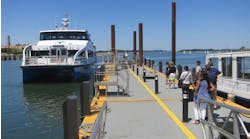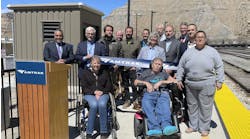Admiral Thad Allen, in an interview for Harvard Business Review’s November 2010 edition, responded to a question about the impact of social media on his work on the BP oil spill crisis, said: “John Holdren, who’s the science and technology adviser to the president, says that there are three ways to deal with climate change: Adapt, manage or suffer. ... And the public participation will happen whether it’s managed or not. We’ve chosen to try to manage. Before the oil spill, I had already started blogging and tweeting.”
November 2010, King County, Washington
I woke up at 3:15 a.m. on the Monday morning before Thanksgiving. There was snow on my yard – fairly deep snow, considering I live in the Pacific Northwest. Our region is usually known for rain – not snow! It was very cold. I live on a hill. As I descended toward my freeway entrance, the roads improved marginally. Freeway conditions were moderately good. But the promise of more snow hung in the air. Soon I would learn that King County Metro was chaining the buses; the Adverse Weather plan had been put to work.
Two years ago, in 2008, our region took a beating with the worst snow storm in a decade. All public services were pushed beyond reasonable capacity – including all the local transit agencies. High transit demand, un-sanded streets, stuck buses, sluggish delivery of transportation information and an attempt to do too much, combined with the weather to create the perfect storm. Public expectations were high. Delivery on those expectations missed the mark. Public criticism was shrill – especially over the lack of information.
In the intervening two years, King County Transit has totally re-worked its approach to adverse weather operations. Cross-functional teams from nearly every transit workgroup helped revise Metro’s approach to snow. King County’s adverse weather operations manual was re-written, internal and external communications channels were refined, equipment was prepared for adverse weather. The plan includes five stages of weather response, ranging from a weather watch to an Emergency Service Network – serving only essential routes. Close coordination was developed Seattle Department of Transportation and other jurisdictions to maintain passable roads on major transit lines.
Tuesday morning made me wish for Monday. When I left work Monday, the road conditions were poor but passable. Conditions worsened Monday afternoon and overnight. By morning, northbound SR-167 and I-5 were littered with abandoned cars. Traffic was very sluggish. It took me nearly an hour to make a 28-mile trip.
As I approached Seattle, a car slid slowly across four lanes of I-5 – missing all other vehicles coming to a hard stop at a retaining wall. Near my exit, long lines of semis were wisely parked for the night. It was far too slick for tractor-trailer rigs to continue. The long-expected La Niña effect sent a shiver down my spine as I walked from the parking garage to King County’s Transit Control Center (TCC).
As I entered my work site on Tuesday, things were not as quiet as Monday morning. The front office was brightly lit. Many of my co-workers had been on duty since 1:00 a.m. Some had spent the night. Many buses were stuck in the snow during the afternoon. Most had been cleared for duty by morning but the work was on-going. The TCC conference room filled up with workers from other departments – maintenance, base operations, service quality, customer service and others. All had been trained to work in the TCC Division Operations Center (DOC). As I soon observed, the DOC played a key role in the effectiveness of our mission during this brief snow event.
I have worked in the Transit Control Center for about a decade. Although I missed the 2008 snow event, I have experienced several snow storms since I first began working in the department. Transitionally, coordinators and TCC management have been responsible for managing all information flow, including calling for sanding, towing, operator transportation, driver shift relief (road relief) problems, and information given to customer service. Sometimes we had help with phones or other tasks but it always appeared ad hoc and not well-organized.
There comes a point in any process where demand can overwhelm capacity. In recent years, this point has been reached more frequently during snow storms. Under normal circumstances each coordinator may be responsible for as many as 300 buses or more. That responsibility means handling all radio calls, phone calls, information requests and coordinator initiated calls for help – such as equipment or personnel changes. Under snowy conditions this becomes impossible to do efficiently.
This time the DOC picked up a lot of slack. Working in a conference room next to our operations center, they were nearly out of site. My first clue to their success was the lack of the constant phone calls of the past. Yes, there were calls to the TCC, but the volume was diminished tremendously. Coordinators were still inundated with radio calls. Behind the scenes, however, sanding, towing, operator shift changes and stuck-bus retrievals were worked on – freeing coordinators to answer the radio. Customer information with regular updates about the status of specific routes went out to the public. Email, text and the Web were used to keep customers up to date.
The storm was indeed tough to operate in. There were some complaints about bus tracking turned off when buses were on snow routes. Others are discussing the tough challenges transit faces with snow operations in Seattle. Generally, I’ve seen positive reviews of Metro’s work during the snow.
King County Metro is still doing a self-evaluation (“debriefing”) of how transit operations went – focusing on the adverse weather plan. I don’t know the gist of these discussions. No doubt there will be tweaks to the plan. However, I personally consider the effort to have been a general success.
What interests me most is whether Metro’s cross-functional adverse weather teamwork will play into other endeavors. Adversity has pushed King County Metro into a new mode of working. Adversity may come again in another form – budget perhaps. Will the collaborative experience gained through creating and implementing this plan create a paradigm transferrable to other work? I hope so.


